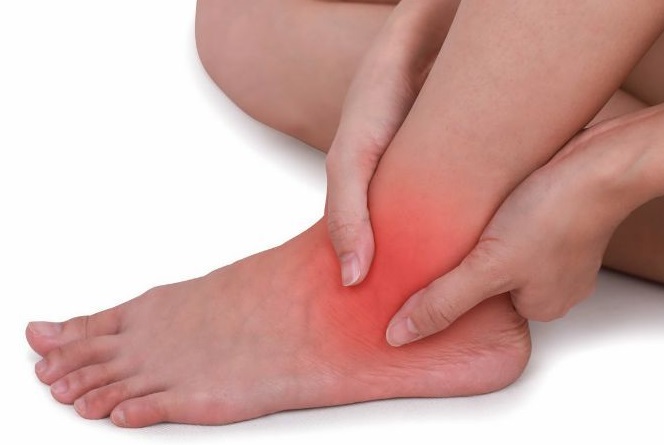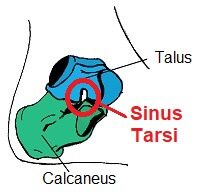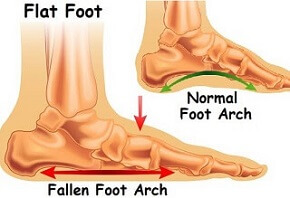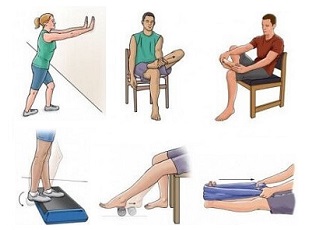- Home
- Common Foot Problems
- Sinus Tarsi Syndrome
Sinus Tarsi Syndrome
Written By: Chloe Wilson BSc(Hons) Physiotherapy
Reviewed By: FPE Medical Review Board

Sinus Tarsi Syndrome usually develops following an ankle sprain or due to repetitive strain from running or walking on a flat foot.
Also known as Sinus Tarsitis, it causes persistent pain and tenderness over the outside of the ankle due to inflammation.
When treated early, recovery from sinus tarsi syndrome is quite quick but without appropriate, early intervention it can lead to chronic pain. Accurate diagnosis is often missed. nyone with persistent pain and instability, particularly if they have previously sprained their ankle, should be thoroughly assessed for this condition.
Here we will look at what the sinus tarsi is, what causes sinus tarsi syndrome, the symptoms of the condition, how it is diagnosed and the best treatment options.
What Is The Sinus Tarsi?

The sinus tarsi is a small cylindrical cavity found on the outside part of the hindfoot. It sits between the talus and calcaneus (heel bone), an area known as the subtalar joint.
A number of ligaments, blood vessels and nerves pass through the sinus tarsi. It plays an important role in balance and proprioception. Inflammation around this region or injury of any of the surrounding ligaments results in Sinus Tarsi Syndrome.
What Causes Sinus Tarsi Syndrome?
Sinus tarsi syndrome is rare condition, usually caused by instability of the subtalar joint in the ankle. The two most common causes of subtalar instability are:

- Abnormal Foot Biomechanics: People with over-pronated or flat feet are more likely to suffer from sinus tarsitis. The altered foot position increases the pressure on the sinus tarsi region
- Ankle Sprains: Instability of the subtalar joint is a common problem following an ankle sprain. Sinus Tarsi Syndrome may develop after a single sprain or after repeated injuries. This instability causes excessive movement at the subtalar joint which can lead to inflammation (known as synovitis) and the formation of scar tissue in the sinus tarsi canal.
Some other activities that can cause sinus tarsi syndrome from repetitive actions include:
- Ballet: due to foot positions
- Sitting: with your feet tucked underneath you
- Baseball/Softball Pitchers: due to the position of the trailing foot
Common Sinus Tarsi Symptoms
The most common sinus tarsi symptoms are:
- Pain: tends to be localized to the sinus tarsi area and feels deep inside. Gets worse with prolonged activities such as walking or running and eases with rest
- Instability: especially when exercising on uneven ground or slopes,
when jumping or quickly changing direction
- Stiffness: the ankle may feel stiff first thing in the morning and then improve as you get moving around and loosen up
- Tenderness to Touch: around the outside and front of the ankle
- Pain with Ankle Movements: especially inversion (turning the sole of the foot inwards) and plantarflexion (pointing the foot down)
Symptoms of sinus tarsi syndrome tend to come on gradually over time. If you have injured the ankle, the symptoms of the initial injury tend to never fully settle, so even though the injured ligament heals properly, you are left with pain due to the resultant irritation of the sinus tarsi area.
Sinus tarsi syndrome is most common between the ages of 10 and 30.
Diagnosing Sinus Tarsi Syndrome
An MRI scan is the best way to see what is going on in the sinus tarsi structures. It will show any inflammation and fibrosis in the area.

Another common diagnostic tool is to inject the sinus tarsi region with local anaesthetic and corticosteroids. Cessation of symptoms (i.e. they go away) indicates a positive diagnosis of sinus tarsi syndrome. The effects of the injection are usually short lived and further treatment will be required.
If symptoms fail to settle after an injection, the problem is unlikely to be sinus tarsitis.
Treatment & Prognosis
When diagnosed early, a full recovery can be made in just a few weeks. However, if the problem is not addressed in the early stages, or if a rehab programme is not adhered to, sinus tarsi pain can become a chronic problem taking months to settle down.
Treatment for sinus tarsi syndrome usually consists of:
1. Rest
Rest is essential with Sinus Tarsi Syndrome. Any activities which triggers the sinus tarsi pain needs to be avoided to allow time for the tissues to heal. This may require the use of crutches and or an ankle brace in the short term. The most common cause of prolonged pain from sinus tarsi syndrome is failure to rest for aggravating activities.
2. NSAID's
Your doctor may prescribe non-steroidal anti-inflammatories which help to reduce pain and inflammation. Always consult your doctor before taking any medication.
3. Regular Ice
Applying ice regularly helps to reduce pain and inflammation. Ice massage is particularly useful here as it closely targets the sinus tarsi region. Visit the Ice Treatment section to find out how to use ice safely and effectively.
4. Physiotherapy
Regular physiotherapy helps to address the cause of sinus tarsitis, be it hypermobility of the subtalar joint or altered foot biomechanics which in turn reduces the symptoms. It may include:
- Joint Mobilisations: to address any areas of stiffness around the ankle,
- Taping: to limit movement of the subtalar joint and reduce the amount of pronation by supporting the medial longitudinal arch of the foot,
- Ultrasound: to reduce inflammation
- Rehab: exercises to strengthen and stretch the area (see below)
5. Footwear
Supportive footwear to restrict excessive rear foot movement rather than open backed shoes can be helpful. If you have abnormal foot biomechanics such as flat feet, you might also be recommended to try orthotics such as shoe inserts to correct this.
6. Exercises
Exercises should only be started once sinus tarsi pain has settled. It is fine to exercise the other muscles of the leg, but ankle exercises should be avoided until they are pain free.
Once the symptoms have settled down, you can start gradual stretching exercises, particularly concentrating on calf stretches, and strengthening exercises for the calf, ankle and foot muscles.
7. Stability Training
To make a full recovery, balance and proprioception training is vital to prevent any instability around the subtalar joint.
8. Graded Return to Activity
Once sinus tarsi syndrome symptoms have subsided, you can gradually return to your usual activities. It is important to pace yourself and not try to do too much too soon, or you may flare the condition up again.
9. Surgery
Whilst rarely necessary, if the symptoms of sinus tarsi syndrome fail to settle using these methods, surgery is required. This may be to remove any chronic synovitis (inflammation) and scar tissue, reconstruction of the ligaments or arthrodesis – fusion of the subtalar joint.
What Else Could It Be?
Sinus Tarsi Syndrome is rare and there are a number of other causes of pain on the outside of the ankle/foot region. For more help working out what is wrong, visit the Side Foot Pain diagnosis section or if your symptoms are more widespread, the foot pain diagnosis overview.
Related Articles
Page Last Updated: 09/10/22
Next Review Due: 09/10/24







